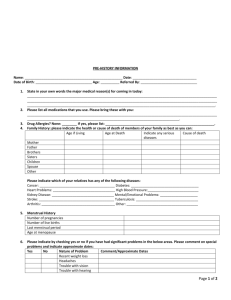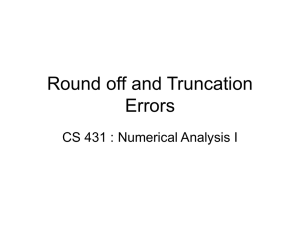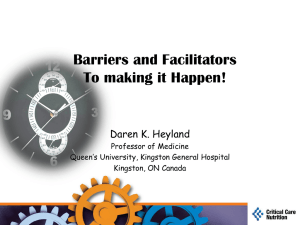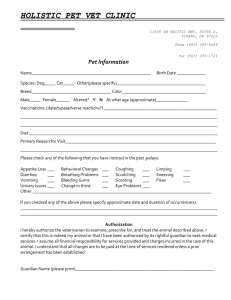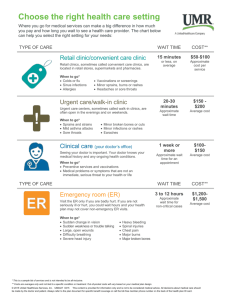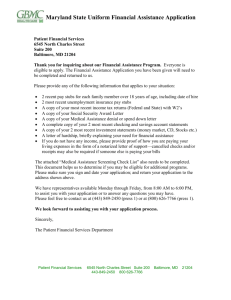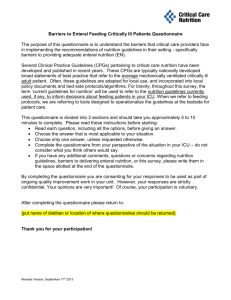Survey in English - Lebanese Society of Critical Care Medicine
advertisement
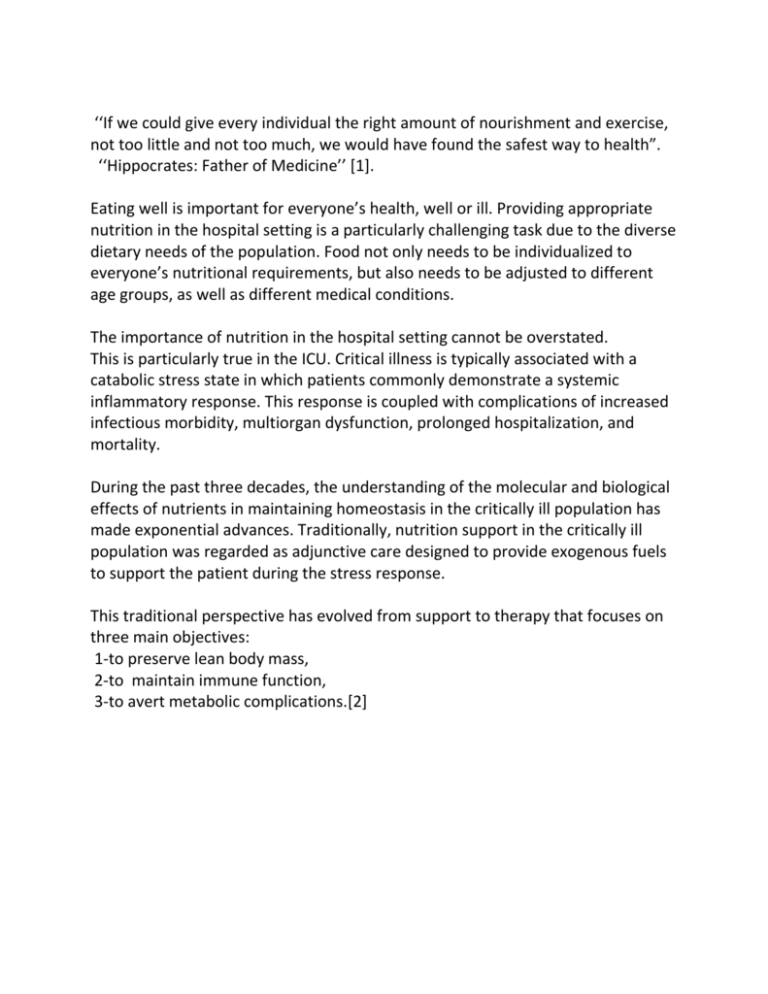
‘‘If we could give every individual the right amount of nourishment and exercise, not too little and not too much, we would have found the safest way to health”. ‘‘Hippocrates: Father of Medicine’’ [1]. Eating well is important for everyone’s health, well or ill. Providing appropriate nutrition in the hospital setting is a particularly challenging task due to the diverse dietary needs of the population. Food not only needs to be individualized to everyone’s nutritional requirements, but also needs to be adjusted to different age groups, as well as different medical conditions. The importance of nutrition in the hospital setting cannot be overstated. This is particularly true in the ICU. Critical illness is typically associated with a catabolic stress state in which patients commonly demonstrate a systemic inflammatory response. This response is coupled with complications of increased infectious morbidity, multiorgan dysfunction, prolonged hospitalization, and mortality. During the past three decades, the understanding of the molecular and biological effects of nutrients in maintaining homeostasis in the critically ill population has made exponential advances. Traditionally, nutrition support in the critically ill population was regarded as adjunctive care designed to provide exogenous fuels to support the patient during the stress response. This traditional perspective has evolved from support to therapy that focuses on three main objectives: 1-to preserve lean body mass, 2-to maintain immune function, 3-to avert metabolic complications.[2] Recently, these goals have become more focused and nutrition support teams were created. Their intervention aims at attenuating the metabolic response to stress, preventing oxidative cellular injury, and favorably modulating the immune response. All these measures may reduce disease severity, diminish complications, decrease length of stay in the ICU, and favorably impact patient outcome. But, despite all these efforts, various nutrition surveys in hospitals continue to suggest that 40% to 50% of patients, particularly those in the intensive care unit, have a moderate to severe degree of malnutrition, with its significant negative impact on clinical outcomes. Indeed several shortcomings can be still identified in the nutritional care of hospitalized patients from the moment of admission to discharge and beyond. [1] brainyquote.com/quotes/authors/h/hippocrates.html [2] Crit Care Med 2009 Vol. 37, No. 5 All that being said, and in order to better understand and evaluate the current usage of nutrition support in our community and to design fruitful educational sessions on nutrition support, please take a few minutes to fill the following questionnaire: 1. Practitioner: Physician Pharmacist Dietitian Nurse Other 2. Name of institution: 3. Academic affiliation: University Hospital 4. Location of institution: Beirut Mount Lebanon North Bekaa South University Affiliation Private Hospital 5. Number of beds: 10 to 50 51 to 100 101 to 200 > 201 6. What is the approximate percent occupancy in your institution: 25% to 50% 51% to 75% 76% to 100% 7. Have you used a specific nutritional screening test? Yes No 8. If yes which test? …… 9. What is the approximate percentage of patients placed on oral supplements at any given time during their hospital stay: 0% to 10% 11% to 20% 21% to 30% 31% to 40 % > 41% (Specify: ……) 10. What is the approximate percentage of patients placed on enteral feeding (Gavage and ready to hang formulas) within 48h of ICU admission? 0% to 10% 11% to 20% 21% to 30% 31% to 40 % > 41% (Specify: ……) 11. What is the approximate percentage of patients placed on enteral feeding (Gavage and ready to hang formulas) at any given time during their hospital stay: 0% to 10% 11% to 20% 21% to 30% 31% to 40 % > 41% (Specify: ……) 12. What is the approximate percentage of patients on enteral feeding that are on ready to hang formulas: 0% to 25% 26% to 50% 51% to 75% 76% to 100% 13. What is the approximate percentage of patients sent on home EN: 0% to 10% 11% to 20% 21% to 30% 31% to 40 % > 41% (Specify: ……) 14. What is the approximate percentage of patients sent on home oralm supplements: 0% to 10% 11% to 20% 21% to 30% 31% to 40 % > 41% (Specify: ……) 15. What is the trend in usage of EN support over the past 5 years: Unchanged Decreasing trend Increasing trend: 0% to 5% 6% to 10% 11% to 20% 21% to 40 % > 41% (Specify: ……) 16. What is the approximate number of patients who are receiving PN during their hospital stay: 0 to 2 / week 3 to 5 / week 6 or more / week 17. How many patients have you approximately sent on home PN during the past 2 years: ……………… 18. What is the trend in usage of PN support over the past 5 years ? Unchanged Decreasing trend Increasing trend: 0% to 5% 6% to 10% 11% to 20% > 21% 19. What is the approximate percentage of patients prescribed PN in the first week of ICU admission? 0% to 10% 11% to 20% 21% to 50% > 51% 20. What is the approximate percentage of patients kept without nutrition support (NPO, off EN, and off PN) for more than 7 days in your institution: 0% to 5% 6% to 10% 11% to 20% > 21% 21. How many beds in your ICU: ……………….. 22. What is the approximate percentage of patients on EN support in your ICU? 0% to 5% 6% to 10% 11% to 20% > 21% 23. What is the approximate percentage of patients on PN support in your ICU? 0% to 5% 6% to 10% 11% to 20% > 21% 24. What ready to hang EN formulas do you currently use? o o o o 25. What PN formulations do you currently use? o o o
